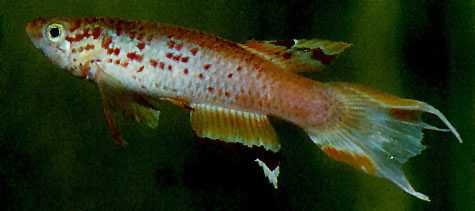
photo by Dirk Bellstedt |
| Gold australe (male) with no tail markings |

photo by Dirk Bellstedt |
| Gold australe (male) with no tail markings |

photo by Dirk Bellstedt |
| Yellow australe (female) |
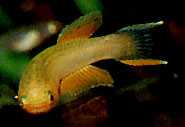
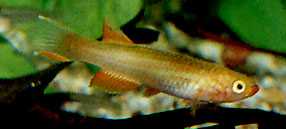
photos by Dirk Bellstedt |
| Yellow australe (male) |
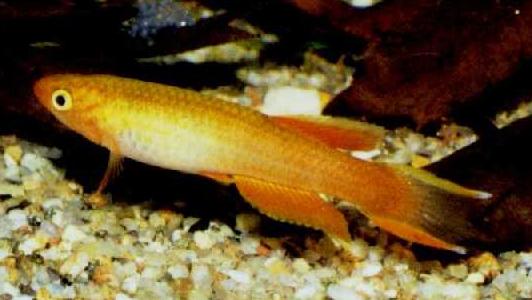
photo by Dirk Bellstedt |
| Yellow australe (male) original(89k) |
Dirk Bellstdet wrote:
|
You may remember the discussion that we have had a few months
back about Aphysemion australe gold without tail markings. I think
that Andrew indicated to us that a similar mutant had appeared in the
tanks of Erling Jensen in New Zealand. At any rate I wish to report
on our findings here in this regard and another colour variant of A
australe gold that has appeared in my tanks.
Early in 1997, I received two trios of AUS gold that a friend brought along from Berlin in Germany. They were obtained from two different dealers so as to obtain a broader genetic base and an AUS chocolate female also came along (the chocolate male died before arrival). I passed on one of these trios to Otto Schmidt so that a we would have a better chance of getting them established and also because Otto had some old golden australe which he was battling to breed. I might add that the fish from the two dealers were not kept separate so we do not know in which combination I spilt them. Interestingly, in the offspring that we obtained from these trios, both Otto and I obtained a single male each without the tail markings and I have included an image of Otto's fish so that you can see what they look like (ausgold1.jpg). Otto has obtained normal gold male offspring and also males with the same lack of colouration from matings of this fish with normal gold females. I passed on my male AUS gold minus tail markings to a friend who had imported AUS golds and had lost all her males. She then also obtained normal gold offspring and those lacking the tail colouration from this male and her females. This would seem to indicate that a dominant gene is controlling this character as it is to be expected that her strain did not possess the mutant gene. The mail fish, due to the lack of dark colouration in the tail are not as striking as normal gold males but I have now again obtained some males minus tail markings from this friend and these actually have a lovely orange colour in the tail which is quite attractive. Once I have made some pics I will also post them. What really excites me, however, is another colour form which appeared from my gold trio which I kept together with the single chocolate female. In the first generation offspring there were a few normal gold males, the male gold minus tail markings male, a normal chocolate female and three gold females.One of these golden females got yellower and yellower and I now have what I will refer to as an Yellow AUS female (See attached, yellow1.jpg). She is really quite different to the normal AUS gold females and quite striking with her yellow colouration. I have now bred her to a normal golden AUS male and I now have the first yellow offspring appearing. The first little male is now developing his colour and what an interestingly coloured fish he is turning out to be. The images that I have made of him are not particularly good, because he is only about 2.5 cm long but I have attached them as yellow2.jpg and yellow3.jpg. As you can see there are all shades of the rainbow appearing but without contrasting dark markings and it will be very interesting to see what colours he will eventually end up with when he is adult. As you can imagine he is receiving the necessary tlc. I have about 20 smaller offspring growing along quite nicely and it will also be interesting to see how they develop their colours. I intend mating the little yellow male back to his mother to try to breed pure yellows. Once again I would guess that one is dealing with a single dominant gene inheritance here and that at this stage the fish that I have are heterozygotes. It will be interesting to see if homozygotes will have the same colour or may possible be paler. I also ask myself whether the original female may have arisen from the chocolate female and the golden male, who knows? At any rate, Otto Schmidt and I intend writing an article about the whole affair, it really is turning out to very interesting. |
| source: AUNZZA mailing list (Sep. 1 1998) |
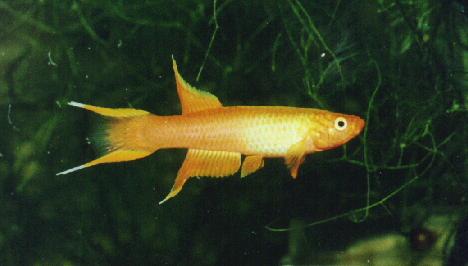
photo by Dirk Bellstedt |
| Yellow australe (male) |
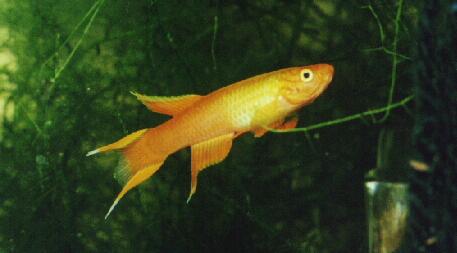
photo by Dirk Bellstedt |
| Yellow australe (male) |
Dirk Bellstedt wrote:
|
The yellow male
australe has now grown out fully and is no longer yellow but bright
orange! Really a stunning fish as you will see on the accompaning
pics. I am not quite sure what one should call this colour variety
but yellow would be incorrect, perhaps I should call them Australe
full orange. Any suggestions? I have now put him in a tank with his
mother and the first eggs started appearing about a month ago. I have
just recently hatched the first fry and the question will of course
be whether they will breed true. If I am to hazard a guess, I would
say that I think that they will breed true because I think I am
beginning to understand the full picture of all these australes
without markings.
A number of the young offspring of the original yellow female and the normal australe male are now almost fully grown and a pattern is emerging. Firstly, there are more male full orange males and yellow females. Then there are males which just have a few dark dots on the head region. Then there are males that have more dark markings and some markings in the dorsal and ventral fins or either the dorsal or the ventral fin, but no markings in the tail. Furthermore there are fish that could be viewed to be normal males but with poor dark markings and then there are normal males with strong dark contrasting colours. I have tried to indicate this spectrum of markings in the sketch. The same spectrum of females is now also emerging. There are some females which are completely yellow without any dark markings whatsoever. Then there are some that just have the faintest of dark markings in the ventral and dorsal fins and then there are some with additional dark markings on the head. In the case of the original female, I would place her in this category. All of these females have the very strong yellow colour. Then there are females which are straw coloured and have very faint dark dots and then there are the normal females, straw coloured and with the prominent strong dots as normal australe gold females have. I have again indicated this spectrum of dark markings on the sketch as well. It therefore would appear as though the character of the no tail markings is related to the character of no markings at all. The condition appears to be controlled by what would be referred to as a quantitative gene. It appears as if there are different dosages of this gene which determine the dark markings. This is also the reason why I believe that the strain will breed true, but we will have to see. It also appears that this is not a xanthomorphic or yellow form, it is rather a australe gold without dark markings. I have noted one full orange male that actually has a poor colouration and is not so orange. Often, one does find normal australe gold males that are pale and do not have a strong orange colour. I think that this little male will also remain pale, but without the dark markings. This brings to another question to mind. If this condition is controlling the dark markings, it should be possible to breed a normal wild type chocolate australe without dark markings. When I originally received these fish I also received a single chocolate female and have been able to breed back chocolates by crossing this female with a normal gold male. This male was related to the aus gold minus tail marking fish. Well, amongst the offspring of these chocolates, I now have the first chocolate male without some tail markings and two females have appeared that have no dots whatsoever. Could these be chocolate females without dark markings? I intend crossing them with the chocolate male minus tail markings and in a next episode, I will be able to inform you of my progress. |
| source: email form Andrew Broome (Nov. 25 1998) |
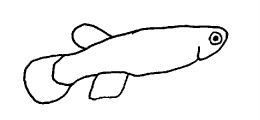 |
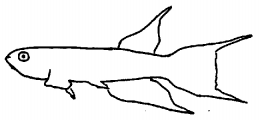 |
| Full orange males | |
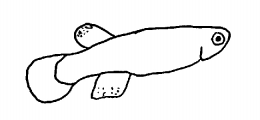 |
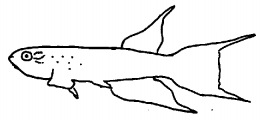 |
| Males which just have a few dark dots on the head region | |
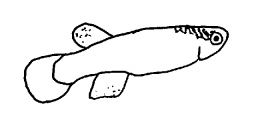 |
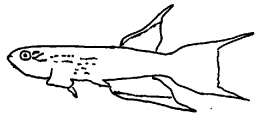 |
| Males that have more dark markings and some markings in the dorsal and ventral fins or either the dorsal or the ventral fin, but no markings in the tail | |
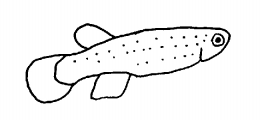 |
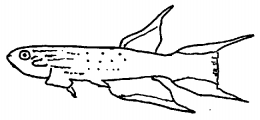 |
| There are fish that could be viewed to be normal males but with poor dark markings | |
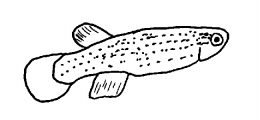 |
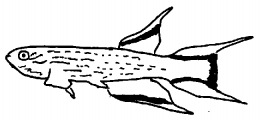 |
| Normal males with strong dark contrasting colours |
Last updated 1 July 2004